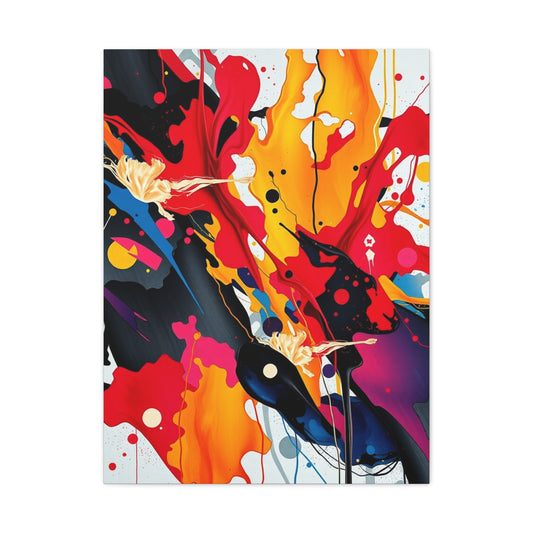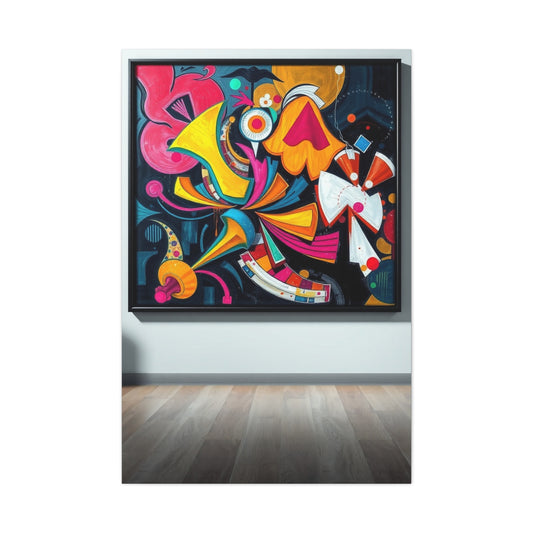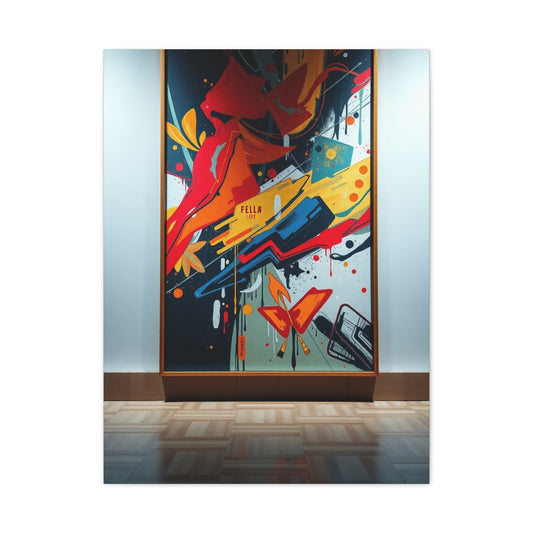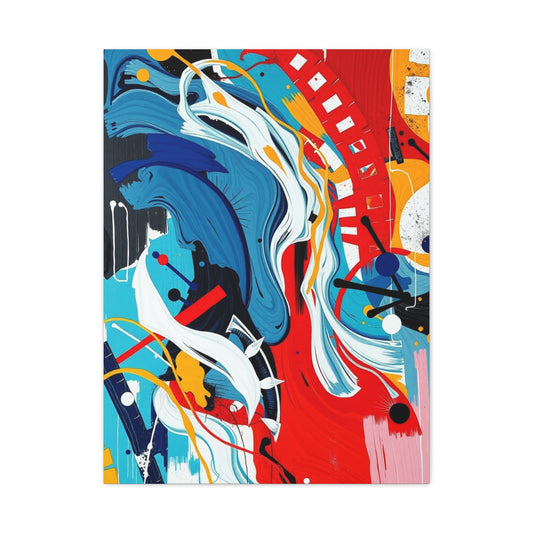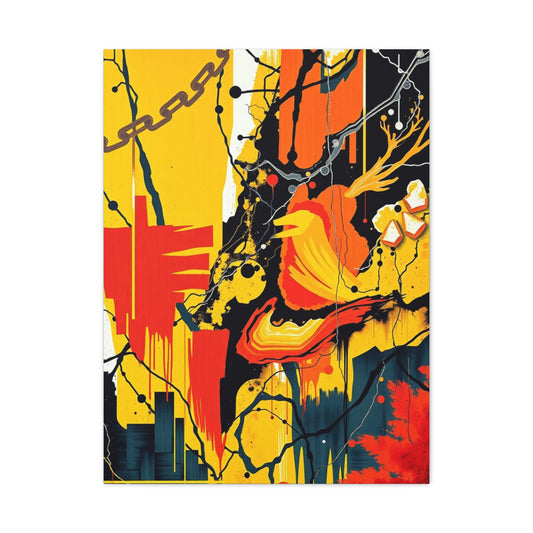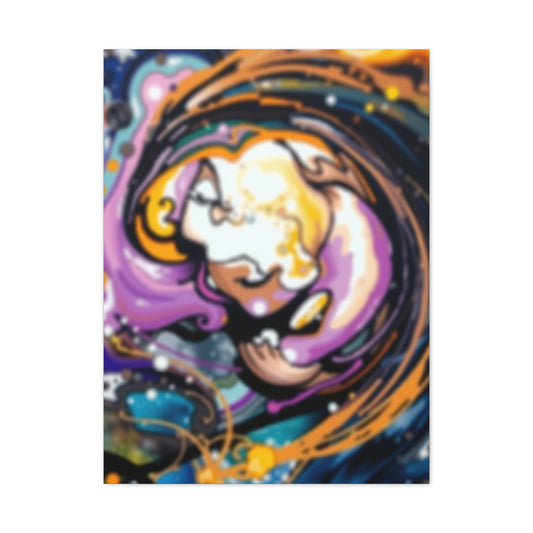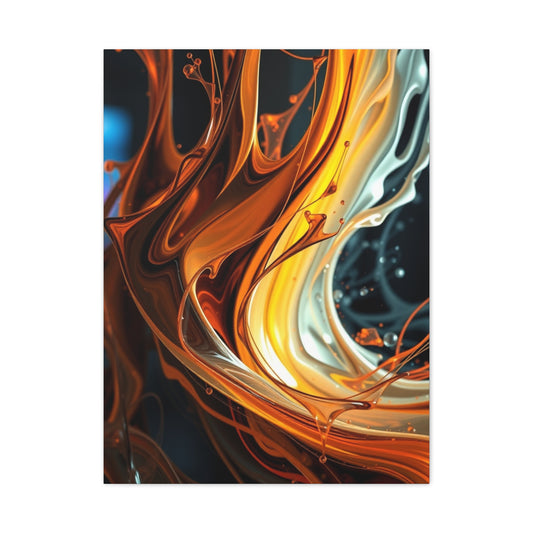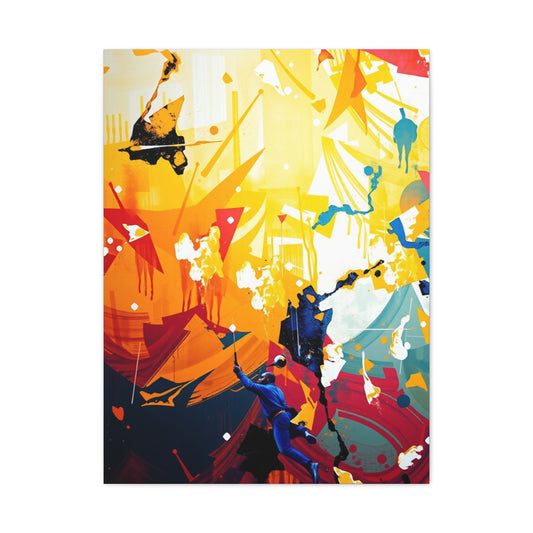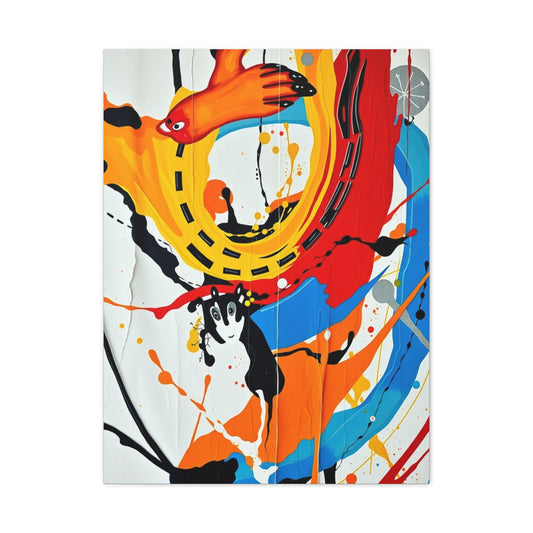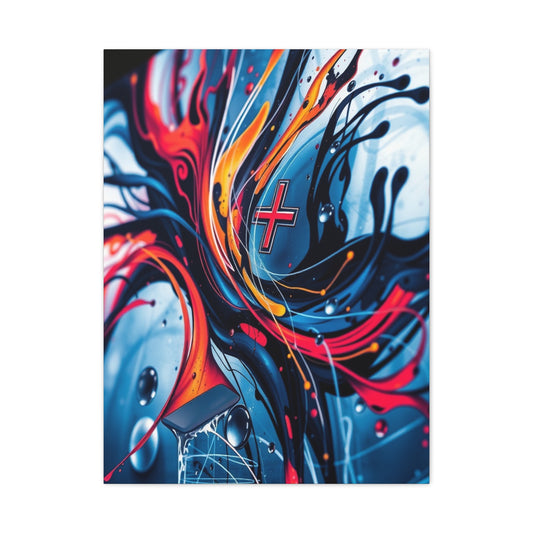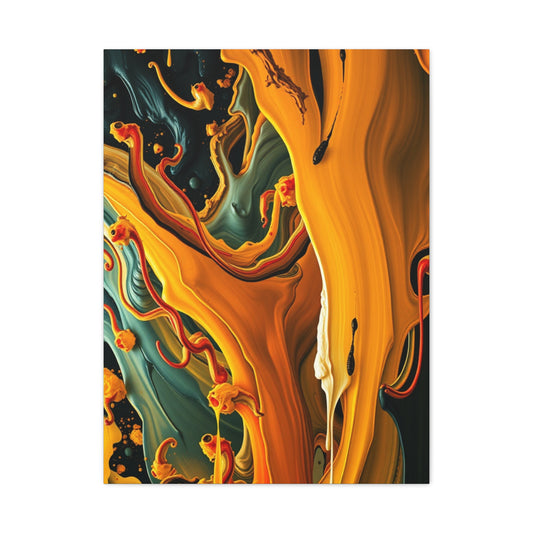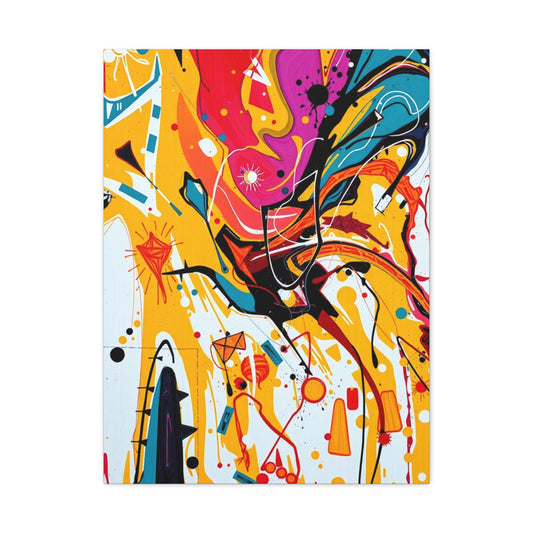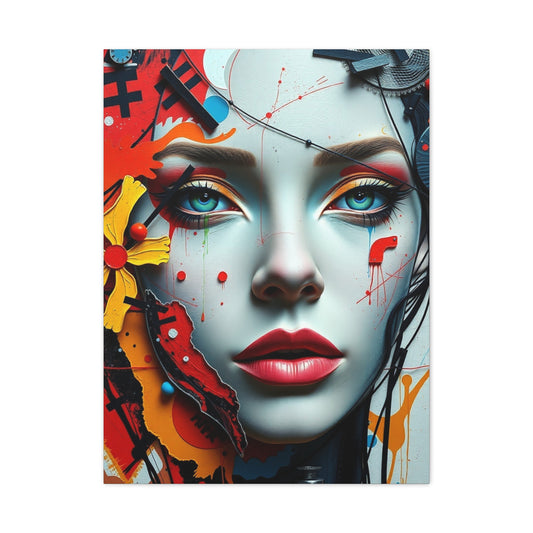Collection: Abstract Wall Art
The Ultimate Guide to Abstract Wall Art Trends for 2025
In 2025, abstract wall art is all about bold color palettes, geometric shapes, and immersive textures that transform ordinary spaces into vibrant, inviting environments. Imagine electric blues paired with sunny yellows that uplift your mood, while layered textures and mixed media techniques add depth and intrigue. Digital and customizable pieces allow your walls to reflect your unique story, creating an exciting way to personalize your home. Let’s explore the trends shaping abstract wall art in 2025 and how they can elevate your surroundings.
Design Highlights
Bold color palettes, featuring vibrant combinations like electric blue and sunny yellow, will dominate abstract wall art in 2025. Geometric shapes and patterns enhance visual interest through symmetry, asymmetry, and dynamic forms. Layered textures create depth, inviting exploration and tactile engagement. Innovative techniques, including digital art and interactive installations, transform wall decor into immersive experiences. Minimalist approaches continue to thrive, offering clean lines, customizable pieces, and artworks that reflect personal stories and evolving tastes. These design highlights illustrate the evolution of abstract wall art into a versatile medium that transcends decoration. Walls are no longer just a backdrop; they become an integral part of interior storytelling, shaping mood, guiding movement, and reflecting personality. Artists are blending classical techniques with contemporary innovation, ensuring that every piece resonates emotionally and visually. The interplay of vibrant hues, geometric precision, tactile richness, and technological augmentation allows homeowners to craft spaces that feel immersive, alive, and uniquely their own. Each element—from color to texture to form—is deliberately chosen to provoke engagement, inspire curiosity, and provide a sense of harmony or excitement depending on the desired ambiance.
Bold Color Palettes
Bold, vibrant hues are taking center stage in 2025, transforming spaces with emotional impact. Colors evoke moods—calming blues or energetic reds—and the right abstract wall art amplifies these effects, making your walls a focal point. Using wall art to complement bold palettes can elevate your home, creating harmony and cohesion. Experimenting with combinations allows your personality to shine through your decor. Unique pieces can add depth and interest, making each room feel lively, inviting, and full of character.
The trend toward audacious colors reflects a growing appreciation for their psychological and emotional effects. Electric blues can energize a creative workspace, while radiant yellows can brighten a dining area, invoking optimism and warmth. The juxtaposition of contrasting colors, such as deep purples with bright oranges or turquoise with coral, produces visual excitement and encourages the eye to travel across the surface. Gradients and blended tones offer subtlety within boldness, allowing for transitions that feel natural yet striking. Incorporating metallic accents, shimmering glazes, or iridescent layers enhances the perception of depth and movement, creating a dynamic wall experience. Color blocking, once a staple of fashion and graphic design, now finds a home in wall art, allowing for playful combinations that challenge traditional aesthetics. By experimenting with hues and layering techniques, homeowners can craft spaces that reflect not only visual taste but emotional resonance, ensuring that each room communicates a distinct personality and mood.
Geometric Shapes and Patterns
Geometric shapes and patterns are making waves in abstract wall art. Symmetry offers balance and calm, while asymmetry sparks energy and curiosity. Layered textures and nature-inspired motifs, such as floral or organic patterns, enhance these designs, creating spaces that feel lively and dynamic. Combining color theory with geometric forms can transform walls into visual stories. Bold contrasts and thoughtful arrangements turn your space into a reflection of your personal style and creativity.
The versatility of geometric abstraction allows artists to balance rigor and freedom, order and spontaneity. Triangles, circles, squares, and polygons can be arranged to convey stability, rhythm, or movement, depending on the intended effect. Symmetrical compositions provide a sense of visual harmony, often used in meditation spaces, offices, or bedrooms to promote calmness and focus. Asymmetrical designs, in contrast, generate energy, curiosity, and playful tension, ideal for living rooms, creative studios, or communal areas where stimulation and engagement are desired. Integrating natural motifs—like leaf patterns, water ripples, or fractal-inspired designs—into geometric structures creates a dialogue between the organic and the abstract, softening rigid lines and evoking balance with nature. Layering geometric patterns with varied textures adds dimensionality, allowing shapes to appear as if they are emerging from the wall, creating a sense of depth and spatial intrigue. Additionally, the strategic use of contrasting colors within geometric frameworks guides the eye through the artwork, turning walls into dynamic narratives that invite exploration and reflection.
Layered Textures and Depth
Layered textures bring walls to life, creating multi-dimensional experiences that invite touch and exploration. Rich textures—from rough canvases to smooth finishes—add interest and foster emotional connections. When paired with geometric patterns, these textures balance complexity and order, making your home more than just a backdrop. Layered abstract wall art encourages engagement, conversation, and immersion.
Textures play an essential role in transforming flat surfaces into interactive visual landscapes. Techniques such as impasto, collage, mixed media, and sculptural reliefs produce surfaces that shift with lighting and perspective, captivating observers. Incorporating natural elements like wood, stone, or recycled materials introduces tactile variety while reinforcing environmental consciousness and sustainability. Mixed media layers—such as fabric, metallic leaf, or textured paint—invite subtle exploration, encouraging viewers to not only look but also imagine the sensation of touch. By creating contrasts between soft and coarse textures, matte and glossy finishes, or rigid and flowing patterns, wall art transcends traditional decoration, generating immersive spatial experiences. Layering can also create the illusion of movement or depth, making walls feel alive and constantly evolving. In large installations, textured layering transforms rooms into immersive environments, where each glance reveals new details and subtle interactions between forms and surfaces. By prioritizing depth, artists craft works that resonate emotionally, captivate the eye, and invite continuous engagement, ensuring that abstract wall art remains a central, dynamic feature of interior spaces rather than a static accessory.
Layered textures combined with thoughtful color selection and geometric frameworks allow homeowners to personalize spaces while creating harmony and visual intrigue. Each piece becomes a conversation starter, sparking curiosity and drawing visitors into the experience. The tactile dimension fosters connection, allowing residents and guests to engage with art in a way that is both sensory and emotional, turning walls into interactive, living narratives that continually transform the energy of the room.
Symmetry vs. Asymmetry
Abstract wall art in 2025 celebrates both symmetry and asymmetry. Balanced compositions evoke calm and serenity, while asymmetrical arrangements generate excitement and energy. Choosing which approach suits your space depends on the mood you wish to create. Wall art can harmonize colors, shapes, and textures, striking the perfect balance between order and freedom, inviting reflection and personal expression.
Mixed Media Techniques
Mixed media wall art opens doors to endless creativity. Collages, layered materials, photographs combined with paint, and found objects make each piece unique. These techniques turn walls into storytelling canvases. Experimentation encourages personal artistic expression. Incorporating innovative mixed media into your decor transforms spaces from simple walls to engaging experiences.
Nature-Inspired Abstracts
Nature-inspired abstract wall art brings the outdoors inside. Organic color palettes—earthy greens, soft browns, creamy whites—evoke serenity and balance, while textured natural elements invite tactile exploration. Biophilic design integrates natural shapes and patterns, creating calming, restorative environments. Incorporating wood, stone, or recycled materials enhances connection with nature, elevating both your mood and your interior aesthetic.
Minimalist Approaches
Minimalist abstract wall art celebrates simplicity, elegance, and clean lines. Subtle colors and restrained shapes create serene spaces, allowing the art to speak without overwhelming the viewer. Minimalist pieces add tranquility, focus, and sophistication, making them ideal for modern interiors seeking balance and calm.
Large-Scale Installations
Large-scale abstract wall art creates immersive, transformative experiences. From wall murals to suspended sculptures and interactive installations, these works engage viewers on multiple levels. Digital projections, interactive panels, and expansive murals invite participation and conversation, turning walls into dynamic, evolving spaces.
Digital Art Integration
Digital art is redefining home decor. Rotating displays, augmented reality experiences, and customizable animations offer interactive, ever-changing designs. Digital abstract wall art lets your home evolve alongside your tastes and lifestyle.
Customizable Art Pieces
Personalized abstract wall art allows you to tell your story. Interactive designs, color-changing elements, and modular compositions invite engagement and creativity. Customizable pieces ensure your walls reflect your personality, evolving as you do.
Caring for Abstract Wall Art
Choosing the Right Art: Consider color psychology, room harmony, and your desired mood. Materials: Canvas, mixed media, and DIY approaches allow for creative experimentation. Maintenance: Dust regularly with a soft cloth and avoid direct sunlight to preserve vibrancy. Affordable Options: Explore marketplaces like Etsy, Society6, or local artists for unique, budget-friendly pieces.
Benefits of Abstract Wall Art
Incorporating abstract art transforms spaces, sparks inspiration, encourages creative expression, and makes your home feel alive. Bold pieces can change the vibe of a room, invite conversation, and reflect your personality. Embrace these trends to elevate your walls and let your space tell a story of individuality and style.
Techniques and Methods
Abstract wall art in 2025 thrives on the harmonious interplay of multiple techniques and methods, each chosen to evoke emotion, intrigue, and personal expression. Layered compositions remain at the forefront, with artists experimenting through both traditional and avant-garde approaches. Acrylic pours meld seamlessly with textured gels, producing fluid patterns that appear almost liquid, inviting viewers to trace their own interpretations across the canvas. Palette knife methods create sculptural surfaces, leaving marks that are simultaneously deliberate and spontaneous, forming tactile landscapes that captivate the senses. Mixed media integrations, such as incorporating fragments of fabric, metallic leaf, or recycled materials, enrich the visual narrative while introducing a tangible depth that transcends conventional painting. Digital augmentation techniques further expand the possibilities, allowing for dynamic overlays, augmented reality interactions, and motion-responsive visuals that respond to the environment or viewer’s movement. Minimalist applications emphasize restraint, where subtle brushwork, muted tones, and negative space coalesce to produce meditative pieces that encourage contemplation. Nature-inspired techniques, employing organic pigments or textured natural surfaces, cultivate a biophilic resonance, creating a sensory bridge between interior spaces and the external environment. Each method carries its own lexicon of expression, enabling wall art to embody layered stories, emotional complexity, and the fluidity of human experience.
Challenges and Common Mistakes
While abstract wall art offers vast creative potential, navigating its challenges requires discernment. One recurring issue is the over-saturation of color or texture, which can overwhelm the visual balance of a space. Without careful modulation, even the most sophisticated hues can clash, undermining the intended emotional impact. Improper layering techniques may result in uneven surfaces, where materials fail to adhere or create unintended voids, diminishing the intended depth. Relying excessively on digital augmentation without considering spatial harmony may disconnect the artwork from the surrounding environment, leading to a discordant experience. Overuse of symmetrical or predictable patterns can stifle the spontaneity that defines abstract expression, whereas inconsistent scaling may disrupt proportion and focus, especially in large-scale installations. Selecting unsuitable materials for high-traffic areas or ignoring environmental factors, such as sunlight exposure, humidity, or dust accumulation, can accelerate wear and compromise vibrancy. A frequent misstep is underestimating the psychological influence of color, where combinations fail to evoke the desired mood or emotional resonance. Balancing bold experimentation with refined aesthetic judgment is critical, as the interplay of innovation and coherence determines whether a piece engages viewers or becomes visually dissonant. Mastering these nuances requires iterative practice, observation, and an intuitive sensitivity to both space and emotion.
Trends and Future Outlook
Looking ahead, abstract wall art in 2025 is poised to evolve through immersive and adaptive experiences. Customizable compositions are growing in prominence, allowing homeowners to interact with elements, shift arrangements, or adjust palettes to reflect personal stories and changing moods. Integration of kinetic elements introduces a dynamic component, where subtle movement or environmental interaction transforms a static wall into an ever-evolving tableau. Biophilic and eco-conscious design principles continue to influence material selection, favoring sustainable, recycled, or organic substances that resonate with environmentally aware audiences. The fusion of traditional techniques with digital innovation is shaping a new aesthetic language, where projection mapping, light-responsive textures, and interactive media redefine spatial perception. Minimalist interventions retain relevance, offering a counterbalance to increasingly complex installations, proving that restraint can coexist with technological sophistication. Multisensory approaches, incorporating subtle scent diffusion, ambient soundscapes, or temperature-sensitive pigments, are emerging as a frontier, expanding abstract art beyond the visual into a holistic experiential domain. Global cultural influences and cross-disciplinary collaborations are enriching the visual lexicon, introducing motifs, patterns, and philosophical undercurrents that transcend geographic boundaries. Adaptive wall art, capable of responding to circadian rhythms, mood indicators, or artificial intelligence-guided algorithms, is gradually transforming interiors into living canvases, merging aesthetic pleasure with technological sophistication and personal interaction.
Expert Insights
Leading artists and curators emphasize that the essence of compelling abstract wall art lies in the balance between innovation and emotional resonance. Techniques that encourage tactile engagement, such as textured layering, mixed media, or sculptural relief, invite viewers to explore the narrative depth of each piece. Experts caution that while digital augmentation offers boundless creativity, it must be harmonized with human-centric design to maintain intimacy and authenticity. Observations from seasoned practitioners reveal that the most impactful works employ deliberate contrasts—between color and shadow, motion and stillness, symmetry and chaos—creating an intricate visual rhythm that guides the observer’s perception. Art advisors suggest prioritizing adaptability in both medium and presentation, ensuring that compositions remain engaging across different spatial contexts and over time. Many specialists highlight the significance of integrating cultural, environmental, and biophilic elements, which elevate wall art from decoration to immersive storytelling. Insights from installations in galleries, residences, and public spaces underscore that multi-sensory considerations, subtle environmental responsiveness, and interactive potential distinguish contemporary abstract wall art from its static predecessors. Above all, experts affirm that curiosity, experimentation, and sensitivity to human emotion are indispensable; they advise embracing risk and deviation from convention, as these often yield the most profound aesthetic revelations.
Emerging Trends in Wall Art
The contemporary landscape of wall art in 2025 reflects a fascinating confluence of innovation, personal expression, and cultural consciousness. Immersive installations are gaining popularity, with walls transforming from static surfaces into interactive canvases that respond to movement, light, or environmental changes. Dynamic layering techniques, which blend tactile materials with digital overlays, are redefining the sensory engagement of viewers. Organic motifs inspired by natural landscapes and biophilic design are increasingly prevalent, bringing the calm and restorative essence of the outdoors into interior spaces. Color palettes are evolving beyond traditional bold or muted schemes to include iridescent and metallic tones, which shift with perspective and light, creating an ever-changing visual experience. Customizable compositions are particularly attractive, allowing homeowners and curators to adjust colors, shapes, or even modular components to reflect personal stories or changing moods. The integration of kinetic elements, such as suspended sculptures that move with air currents, introduces an additional layer of interaction and enchantment. Minimalist and maximalist dichotomies are coexisting, as artists balance restraint with elaborate textures, creating complex yet harmonious arrangements that captivate without overwhelming. Wall art is increasingly functioning as a medium of storytelling, where abstract forms, cultural motifs, and environmental textures convey narratives that are both intimate and universal. Digital augmentation, augmented reality features, and projection mapping continue to redefine the spatial perception of wall surfaces, allowing art to interact with its viewers in ways previously unimaginable. The emphasis on multisensory experiences is also rising, incorporating elements like subtle scent, sound, or luminescent features that elevate the aesthetic from visual engagement to full environmental immersion.
Step-by-Step Guides
Mastering wall art techniques requires understanding each stage of creation and installation to achieve both aesthetic beauty and functional harmony. The process begins with conceptualization, where the artist or homeowner identifies the emotional resonance, narrative, and spatial context of the piece. Sketching or digitally modeling the design helps visualize the interplay of color, shape, and texture. Selecting appropriate materials is crucial; choices range from traditional canvas and paper to mixed media elements, metallic foils, reclaimed wood, or organic pigments, each offering a unique tactile and visual effect. Preparing the surface involves priming, texturing, or layering undercoats to ensure durability and longevity, particularly for large-scale installations. When applying paint or mixed media, techniques such as layering, glazing, palette knife application, or digital augmentation allow for depth, dimensionality, and fluidity. Incorporating geometric patterns, asymmetrical forms, or organic motifs at this stage introduces visual rhythm and movement. Curing, drying, and setting procedures vary depending on materials and environmental conditions, with attention paid to maintaining color vibrancy and texture integrity. Installation begins with spatial mapping, measuring wall dimensions, and considering lighting angles to optimize the visual impact. Hanging hardware, adhesives, or suspension methods are selected based on weight, texture, and interaction requirements. For interactive or digital components, connectivity and calibration ensure seamless integration with the environment. Finishing touches, including protective coatings, framing, or environmental adjustments, complete the transformation, ensuring that the artwork resonates harmoniously with its surroundings. Following these step-by-step principles allows wall art to achieve both artistic expression and functional adaptability.
Sustainability and Ethical Considerations
Sustainability has become an essential dimension in contemporary wall art practices, reflecting both ecological consciousness and responsible artistry. Artists increasingly prioritize eco-friendly pigments, recycled or upcycled materials, and sustainably sourced canvases to reduce environmental impact. Organic dyes, natural resins, and biodegradable mediums are being integrated, allowing the creation of visually captivating pieces without contributing to chemical pollution. Ethical sourcing extends beyond materials to include labor practices and collaboration, ensuring fair compensation and support for local artisans. Circularity in design is gaining attention, encouraging modular or reusable components that can be adapted or repurposed over time. Energy-conscious methods, including low-impact production processes and digital alternatives, minimize carbon footprints while retaining artistic integrity. Incorporating reclaimed objects or discarded materials not only enhances textural diversity but also tells a story of transformation and environmental mindfulness. Water-based paints and non-toxic adhesives reduce harm to both the creator and the audience, while conservation-focused coatings extend the life of artworks, preventing early degradation and waste. Community-driven initiatives, such as workshops, public installations, and collaborative projects, align ethical responsibility with social engagement, allowing art to function as a conduit for education and ecological awareness. These considerations emphasize that wall art is not merely decorative but can embody values of sustainability, integrity, and long-term stewardship, influencing both the creator’s practice and the viewer’s perception.
Global Influences in Wall Art
The evolution of wall art in 2025 is enriched by a multitude of global influences, blending cross-cultural motifs, traditional techniques, and contemporary innovations. Asian minimalist philosophies inspire serene compositions, emphasizing negative space, subtle gradients, and meditative simplicity. African patterns and textures contribute vibrant geometric motifs, naturalistic pigments, and rhythmic compositions that evoke cultural storytelling. European avant-garde traditions continue to infuse experimental forms, abstract conceptualism, and playful manipulation of perspective. Latin American influences introduce bold color palettes, dynamic energy, and narrative-rich symbolism, often integrating folkloric elements or community-centered themes. Indigenous artistic practices contribute textured surfaces, organic materials, and symbolic iconography that honor heritage while adapting to modern aesthetic contexts. Cross-continental collaborations are increasingly common, allowing artists to merge diverse visual languages, materials, and methods, resulting in hybrid forms that resonate across borders. Digital platforms facilitate exposure to global aesthetics, enabling collectors, curators, and enthusiasts to access emerging trends and integrate them into local contexts. The synthesis of these influences produces wall art that is simultaneously contemporary, culturally informed, and deeply personal, allowing spaces to tell multilayered stories that celebrate human creativity and shared experience. Multicultural integration also encourages experimentation with scale, materiality, and technique, leading to artworks that challenge conventional boundaries and invite dialogue between tradition and innovation. Artists increasingly seek inspiration from global narratives while adapting pieces to their own spatial and emotional environment, fostering a wall art ecosystem that is rich, diverse, and forward-looking.
Sustainability and Ethical Considerations
Sustainability in wall art has become an essential ethos, intertwining ecological mindfulness with artistic expression. Contemporary artists increasingly seek materials that are responsibly sourced, biodegradable, or recycled, reducing the environmental footprint while retaining aesthetic integrity. Pigments derived from natural minerals, plant-based dyes, and non-toxic water-based paints have gained prominence, offering vibrancy without compromising ecological health. Ethical considerations extend beyond materials to labor practices, collaborative frameworks, and community engagement, ensuring fair compensation and respect for cultural heritage. Utilizing reclaimed or repurposed elements not only mitigates waste but infuses artwork with a narrative of transformation, telling stories that merge environmental consciousness with human creativity. Artists are experimenting with circular design, creating modular or adaptable installations that can evolve over time, fostering longevity and reducing the need for replacement. Techniques that minimize energy consumption during production and digital augmentation strategies that reduce physical material usage are increasingly favored, allowing innovation without ecological sacrifice. Community-focused workshops and educational initiatives amplify the ethical dimension, promoting awareness and participation in sustainable creative practices. By embedding these principles, wall art becomes more than decorative expression; it embodies responsibility, awareness, and a commitment to a harmonious coexistence between human endeavor and the natural world.
Maintenance and Longevity
The durability of wall art is contingent on careful selection of materials, techniques, and environmental awareness. Artists and collectors must consider the interplay of texture, medium, and placement to ensure longevity and visual integrity. Layered textures and mixed media installations require attention to adhesive quality, curing processes, and surface preparation, as improper layering can lead to delamination or fading over time. Exposure to light, humidity, and temperature fluctuations can affect both pigments and substrates; therefore, strategic placement and protective coatings are essential to preserving vibrancy. Routine maintenance, such as gentle dusting with soft microfiber cloths and avoiding abrasive cleaning methods, prevents accumulation of grime without damaging delicate surfaces. Periodic inspections allow early detection of wear, discoloration, or surface stress, enabling timely intervention. For digital or kinetic elements, firmware updates, calibration, and environmental optimization ensure continued performance, while biodegradable or sensitive materials may require specific conditions to prevent degradation. Large-scale installations and interactive wall art benefit from modularity, enabling parts to be replaced or refreshed without compromising the overall composition. Maintenance considerations are deeply intertwined with the creation process, as materials chosen for sustainability often possess inherent durability, allowing artworks to age gracefully while maintaining visual and tactile richness. By anticipating these factors, wall art can remain a captivating focal point for years, evolving with the space while retaining its original impact.
Wall Art as a Statement Piece
Wall art has transcended mere decoration to function as a profound statement within personal and public spaces. Abstract compositions, bold color contrasts, and intricate textures command attention, transforming walls into narratives that reflect identity, values, and aesthetic philosophy. Statement pieces often employ scale, dynamic forms, or innovative techniques to dominate the visual landscape, inviting viewers to engage emotionally and intellectually. Integration of kinetic elements, interactive digital overlays, or mixed media layers elevates the work from a passive visual object to a participatory experience. Placement within the environment amplifies meaning, whether a commanding mural in a living space, a textured installation in a gallery, or a nature-inspired composition in a meditative area. Materials themselves contribute to the statement, with reclaimed, metallic, or organic substrates conveying ecological awareness, cultural heritage, or artisanal mastery. Artists leverage contrasts between minimalism and maximalism, symmetry and asymmetry, or static and dynamic features to create tension, movement, and rhythm that draw the eye. The narrative potential of wall art allows it to embody philosophical reflection, social commentary, or personal storytelling, making each piece unique to its creator and space. As statement pieces, wall art encourages dialogue, provokes contemplation, and elevates interior environments into immersive experiences that resonate beyond aesthetics.
Bold Colors and Layered Textures
The use of bold colors and layered textures is central to contemporary wall art, offering both emotional impact and tactile intrigue. Vivid combinations evoke moods ranging from energetic optimism to serene contemplation, while layered techniques create depth, movement, and dimensionality. Artists employ glazing, palette knife methods, and mixed media accretions to produce surfaces that invite exploration and engagement. Color contrasts can define space, establish focal points, and influence perception, while textural variation enhances visual complexity and sensory resonance. Organic forms and geometric motifs, when integrated with rich textures, provide a balance between chaos and structure, creating compositions that are both visually compelling and psychologically stimulating. Layering materials such as metallic foils, fabric, recycled elements, or digital projections further intensifies the immersive quality of the work. The interplay of color and texture transforms walls into experiential environments, allowing viewers to navigate emotional landscapes through visual and tactile cues. In modern interiors, these techniques facilitate personalization, ensuring that wall art not only complements the surrounding architecture but also asserts its presence as a meaningful, interactive component of the space.
Interactive and Digital Innovations
Incorporating interactive and digital elements is reshaping the possibilities of wall art. Augmented reality overlays, motion-sensitive projections, and responsive light patterns allow artworks to evolve in real time, adapting to viewer presence and environmental changes. Customizable digital compositions empower individuals to modify colors, patterns, or structural arrangements, creating a dialogue between creator, owner, and space. Kinetic components, such as suspended or motorized modules, introduce movement and temporal variation, expanding the perception of depth and form. Digital augmentation offers novel methods to blend traditional painting, sculpture, and mixed media with technological innovation, producing hybrid experiences that challenge conventional boundaries. Integration requires consideration of power supply, connectivity, and environmental factors, ensuring seamless operation while preserving aesthetic coherence. As interactive technologies advance, wall art transforms into a multidimensional canvas, merging artistic intention with real-time adaptability, fostering immersive encounters that bridge the gap between observer and artwork.
Minimalism and Maximalism in Modern Spaces
Minimalist approaches highlight restraint, clean lines, and subdued palettes, allowing the essence of form, texture, and negative space to dominate. In contrast, maximalist compositions embrace complexity, bold colors, intricate layering, and dynamic patterns that saturate the visual field. Contemporary wall art often juxtaposes these approaches, creating tension and equilibrium within a single installation. Minimalism provides contemplative breathing space, emphasizing conceptual clarity and meditative qualities, whereas maximalism invites energetic engagement, storytelling, and sensory immersion. Thoughtful application of these strategies transforms interior environments, guiding perception, mood, and interaction. Designers and artists carefully calibrate the balance, considering room scale, lighting, and surrounding decor, ensuring that wall art enhances rather than overwhelms the spatial experience.
Cultural and Environmental Inspirations
Cultural narratives and environmental textures profoundly influence contemporary wall art. Motifs inspired by global artistic traditions, indigenous symbolism, or folkloric patterns enrich compositions with layered meaning. Environmental elements, such as reclaimed wood, stone, or natural fibers, contribute both tactile depth and ethical resonance, connecting viewers to broader ecological and cultural contexts. Biophilic integration, emphasizing organic shapes and earth-toned palettes, fosters a sense of serenity and grounding. These inspirations enable artists to bridge heritage, sustainability, and contemporary aesthetic, producing works that resonate with viewers on multiple levels. The dialogue between culture, environment, and abstraction ensures that wall art becomes a vehicle for reflection, identity, and ecological mindfulness.
Large-Scale and Immersive Installations
Large-scale wall art has emerged as a dominant trend, transforming ordinary surfaces into immersive environments. Panoramic murals, interactive installations, and modular compositions redefine spatial perception, allowing viewers to experience art as a total environment rather than a discrete object. Suspended or kinetic components encourage engagement, while textural layering amplifies the perception of depth. Digital augmentation or projection-based overlays enhance immersion, enabling evolving experiences within a static space. The scale of the work interacts with architecture, light, and movement, creating an experiential resonance that is both aesthetic and emotional. Curators and homeowners are increasingly adopting this approach to assert artistic vision, establish focal narratives, and encourage participatory interaction.
Material Innovation and Preservation
Innovative materials play a pivotal role in contemporary wall art, shaping both visual and functional outcomes. Sustainable, recycled, or composite materials provide textural richness while aligning with ethical and environmental priorities. Metallic leaf, natural pigments, organic fibers, and interactive digital substrates expand the possibilities for layered compositions, kinetic motion, and multisensory engagement. Preservation techniques, including protective coatings, UV-resistant finishes, and controlled environmental conditions, extend the lifespan of artworks while maintaining aesthetic integrity. Material innovation allows artists to explore new forms, experiment with scale and depth, and produce work that is resilient yet expressive.
Personal Expression and Spatial Harmony
Wall art functions as both a personal statement and an enhancer of spatial harmony. Abstract compositions, color contrasts, and textural interplay reflect individual taste, narrative, and emotional resonance. Placement, scale, and lighting calibrate the interaction between artwork and environment, ensuring cohesion with architecture and interior design. The selection of materials, motifs, and techniques facilitates dialogue between creativity and context, producing a harmonious balance between personal expression and environmental integration. Wall art becomes a vessel for storytelling, identity, and experiential enrichment, inviting viewers to engage with both space and narrative on a profound level.
Future Directions in Wall Art
The trajectory of wall art in 2025 and beyond is defined by the fusion of traditional craftsmanship with technological innovation, cultivating immersive experiences that transcend static visual engagement. Artists are increasingly experimenting with kinetic forms, augmented reality overlays, and digital interactivity, allowing walls to function as evolving canvases that respond to environmental stimuli and viewer interaction. Customizable compositions are expanding in popularity, offering users the ability to adjust color schemes, modular components, or digital elements to reflect personal narratives and shifting aesthetic preferences. Sustainability continues to influence the selection of materials, with recycled metals, organic pigments, and biodegradable substrates establishing ethical benchmarks while enabling creative exploration. Cross-cultural exchange is shaping aesthetic vocabularies, as motifs, patterns, and philosophies from diverse regions inform global design trends, producing hybridized expressions that celebrate both heritage and innovation. Minimalist approaches are harmonizing with maximalist compositions, allowing spaces to balance visual calm with energetic dynamism. The integration of multi-sensory experiences, such as subtle auditory layers, luminescent materials, or tactile interactivity, is expanding the dimensionality of wall art, making it not only visual but experiential. Artists are also exploring narrative layering, embedding symbolic, historical, or ecological references within abstract forms, enabling walls to communicate stories that are simultaneously personal, social, and environmental. As technology advances, interactive installations that react to touch, motion, or even biometric input are redefining the boundaries between observer and artwork, transforming passive viewing into participatory engagement. This evolution underscores that wall art is no longer merely decorative but a dynamic medium that embodies innovation, emotional resonance, and spatial dialogue.
Experiential Engagement
The experiential dimension of wall art is emerging as a defining trend, where immersive engagement enhances aesthetic appreciation and emotional connection. Interactive textures, layered materials, and responsive digital overlays invite viewers to explore surfaces with sight, touch, and sometimes sound, creating multisensory encounters that extend beyond conventional visual perception. Kinetic elements, such as suspended modules or moving panels, generate rhythm and movement, transforming a static canvas into a dynamic tableau. Color modulation and layered pigment techniques evoke emotional responses, guiding perception and mood while encouraging reflection and interpretation. Large-scale installations and murals redefine spatial awareness, enveloping observers within the artwork itself and creating a sense of total immersion. Biophilic integration, organic motifs, and environmentally inspired textures enhance well-being, offering restorative qualities and bridging the sensory gap between interior spaces and nature. Digital augmentation, augmented reality, and projection mapping introduce temporality and adaptability, allowing art to evolve in real time with viewer interaction or environmental conditions. This fusion of traditional media with technological innovation produces experiential richness, making wall art not only an object of aesthetic admiration but a catalyst for emotional resonance, personal storytelling, and social connection.
Personalization and Narrative in Wall Art
The concept of personalization is increasingly central to contemporary wall art, enabling individuals to embed personal narratives, memories, or identities into visual compositions. Customizable elements, modular arrangements, and interactive digital interfaces allow users to co-create or modify artworks, reflecting evolving tastes, moods, or experiences. Narrative layering is achieved through the thoughtful interplay of color, texture, and form, embedding symbolism, cultural references, or ecological motifs within abstract designs. Mixed media techniques, such as the inclusion of photographs, textiles, or organic materials, amplify storytelling potential, offering tactile and visual depth that invites viewers to decode the narrative. Placement and scale further enhance personalization, allowing walls to assert identity within domestic, public, or professional environments. This trend transforms art from a passive decorative object into a dynamic canvas for self-expression, social dialogue, and experiential engagement, enabling spaces to resonate with authenticity and individuality.
Integration with Interior Environments
Contemporary wall art is increasingly conceived with a holistic approach, harmonizing with architectural features, lighting conditions, and spatial dynamics to optimize impact and resonance. Bold color palettes and layered textures are calibrated to complement furniture, flooring, and architectural details, establishing visual cohesion while retaining expressive vibrancy. Geometric patterns, asymmetrical arrangements, and organic forms interact with light and shadow, producing dynamic effects that evolve throughout the day. Large-scale installations or murals can redefine the perception of spatial dimensions, creating immersive zones that alter circulation, focal points, and ambiance. Minimalist wall art offers contemplative pauses, while maximalist or mixed media compositions introduce energy, rhythm, and complexity. Digital augmentation or interactive elements are seamlessly integrated with interior design, ensuring technological features enhance rather than disrupt the overall aesthetic. Thoughtful integration ensures that wall art functions as a narrative extension of the environment, reflecting personal identity while enhancing experiential quality and visual harmony.
The Role of Sustainability and Ethics
Ethical responsibility and sustainability remain guiding principles in the evolution of wall art. Material selection is informed by environmental consciousness, with recycled metals, reclaimed wood, plant-based pigments, and biodegradable substrates taking precedence. Artists are increasingly mindful of production processes, energy consumption, and long-term durability, ensuring that creative innovation does not come at the expense of ecological integrity. Ethical labor practices, fair collaboration, and respect for cultural provenance underpin contemporary approaches, emphasizing that wall art embodies both aesthetic value and social responsibility. Community-driven initiatives, such as collaborative installations, educational workshops, and public engagement projects, enhance ethical impact while fostering cultural awareness. Sustainability is also evident in modular, adaptable, and repairable designs, allowing artworks to evolve or be repurposed rather than discarded, reinforcing longevity and reducing environmental strain. By embedding these principles, wall art becomes a conduit for both creative expression and ethical stewardship, reflecting values that resonate across generations.
Technological Advancements in Wall Art
Emerging technologies are redefining the possibilities of contemporary wall art, merging traditional artistic methods with digital innovation to produce immersive and adaptive experiences. Augmented reality overlays, interactive panels, projection mapping, and motion-sensitive elements allow artwork to respond to the environment or observer, transforming passive viewing into participatory engagement. Digital customization platforms enable viewers to alter color schemes, modular structures, or visual sequences, creating a personalized interaction that evolves over time. Kinetic components, such as moving modules, suspended sculptures, or light-responsive surfaces, introduce rhythm and spatial dynamism. Integration of AI and responsive algorithms facilitates adaptive compositions that adjust based on light, movement, or user input, producing artwork that is both responsive and reflective of context. These technological advancements do not replace traditional methods but augment them, creating hybrid forms where pigment, texture, and physical layering coexist with digital interactivity. The result is a new paradigm where wall art is simultaneously aesthetic, experiential, and participatory, challenging conventions and expanding the potential for storytelling, emotional engagement, and spatial transformation.
Cultural and Global Influences
Global cultural currents continue to shape contemporary wall art, producing hybrid aesthetics that blend tradition with innovation. Motifs derived from indigenous practices, Asian minimalism, African patterns, European avant-garde, and Latin American symbolism contribute to a rich visual lexicon. Cross-cultural collaborations facilitate the exchange of techniques, philosophies, and materials, producing works that are simultaneously familiar and novel. Organic and environmental inspirations intersect with cultural narratives, resulting in pieces that resonate with both local identity and global sensibilities. Artists increasingly navigate this interplay to produce abstract compositions that carry meaning beyond immediate visual impact, embedding cultural memory, social commentary, and ecological awareness within form, color, and texture. This synthesis ensures that wall art functions as a platform for storytelling, reflection, and cross-cultural dialogue, enhancing both personal and public spaces with layered significance.
Emotional and Psychological Impact
Wall art exerts a profound influence on emotional and psychological experience, shaping mood, perception, and cognitive engagement within spaces. Color psychology, textural richness, and spatial arrangement collectively guide emotional responses, from calm and contemplation to energy and stimulation. Layered textures and interactive elements invite sensory exploration, deepening cognitive and emotional engagement. Large-scale or immersive installations can transform perception of space, heightening spatial awareness and inducing contemplative or awe-inspiring responses. Personalized compositions reinforce identity and self-expression, allowing individuals to inhabit environments that reflect and amplify their inner emotional landscape. The interplay of abstraction, symbolism, and narrative depth provides viewers with interpretive freedom, fostering reflection, dialogue, and a sense of connection with both artwork and environment. By considering these psychological dimensions, artists and curators enhance the capacity of wall art to enrich interior environments beyond mere visual appeal.
Conclusion
As wall art continues to evolve in 2025, it embodies a dynamic intersection of creativity, sustainability, technology, and personal expression. Contemporary practices emphasize interactive engagement, immersive experiences, and the integration of multi-sensory dimensions, transforming walls into canvases of narrative, emotion, and identity. Ethical sourcing, sustainable materials, and community-conscious approaches ensure that artistic innovation coexists with responsibility, while technological integration expands the scope of interaction and adaptability. Global cultural currents, layered textures, bold palettes, and kinetic forms merge to create artworks that are both visually striking and experientially rich. The balance of minimalist restraint and maximalist exuberance offers versatility, allowing spaces to resonate with individuality while maintaining aesthetic cohesion. Through personalization, narrative layering, and spatial integration, wall art becomes a profound statement, a source of inspiration, and a vehicle for dialogue between observer, creator, and environment. Its evolution reflects a broader cultural, ethical, and technological awareness, underscoring the enduring capacity of art to transform spaces, evoke emotion, and convey stories that are simultaneously personal, social, and universal.
